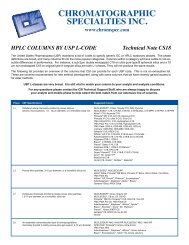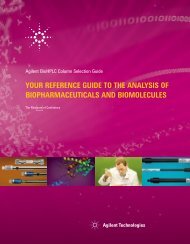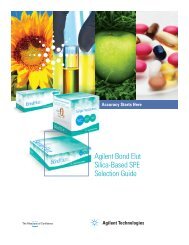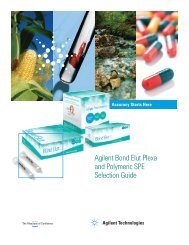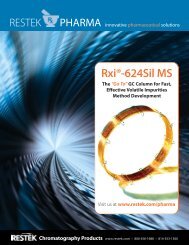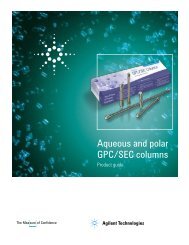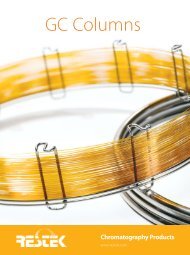Optimizing the Analysis of Volatile Organic Compounds
Optimizing the Analysis of Volatile Organic Compounds
Optimizing the Analysis of Volatile Organic Compounds
Create successful ePaper yourself
Turn your PDF publications into a flip-book with our unique Google optimized e-Paper software.
Figure 47.<br />
<strong>Volatile</strong> organics by US EPA Method 8260B on an Rtx ® -VMS column; conditions optimized for fast Method 8260 analysis.<br />
(Suitable for use with dual purge and trap units.)<br />
20m, 0.18 mm ID, 1.00 m Rtxfi-VMS (cat.# 49914)<br />
<strong>Compounds</strong> at 10ppb in 5mL <strong>of</strong> RO water unless o<strong>the</strong>rwise noted, ketones at 2.5X<br />
Concentrator: Tekmar LSC-3100 Purge and Trap<br />
Trap: Vocarbfi 3000 (type K)<br />
Purge: 11 min. @ 40mL/min. @ ambient temperature<br />
Dry purge:<br />
Desorb preheat:<br />
Desorb:<br />
Bake:<br />
1 min. @ 40mL/min.<br />
245 C<br />
250 C for 2 min., Flow 40mL/min.<br />
260 C for 8 min.<br />
Interface: 0.53mm ID Silcosteelfi Oven temp.:<br />
tubing transfer line (cat. #70045)<br />
1:40 split at injection port. 1mm ID liner.<br />
50 C (hold 4 min.) to 100 C @ 18 C/min. (hold 0 min.)<br />
to 230 C @ 40 C/min. (hold 3 min.)<br />
Carrier gas: helium @ ~1.0mL/min. constant flow<br />
Adjust dichlorodifluoromethane to a retention time <strong>of</strong> 1.03 min. @ 50 C.<br />
Detector: Agilent 5973 MSD<br />
Scan range: 35-300amu<br />
1<br />
3<br />
2 4 5<br />
8 11<br />
13<br />
6<br />
9<br />
10 14<br />
15<br />
7<br />
16<br />
79,80<br />
68,69<br />
82,83 88,89<br />
86 90<br />
85<br />
66,67<br />
71,72 84<br />
76<br />
73<br />
81<br />
78<br />
91<br />
87<br />
64,65<br />
70<br />
75<br />
77<br />
51<br />
24<br />
29-32 35<br />
49<br />
26-28<br />
44<br />
23 33,34<br />
41<br />
45<br />
12 22 25<br />
38<br />
17<br />
43<br />
19-21<br />
50<br />
18<br />
36 37 40 42 46 47<br />
39<br />
48<br />
54,55<br />
59<br />
56<br />
53<br />
58<br />
60<br />
6162,<br />
57<br />
63<br />
52<br />
74<br />
min. 2 4 6 8 10<br />
1. dichlorodifluoromethane<br />
2. chloromethane<br />
3. vinyl chloride<br />
4. bromomethane<br />
5. chloroethane<br />
6. trichlor<strong>of</strong>luoromethane<br />
7. ethanol (2500ppb)<br />
8. 1,1-dichloroe<strong>the</strong>ne<br />
9. carbon disulfide (40ppb)<br />
10. allyl chloride<br />
11. methylene chloride<br />
12. acetone<br />
13. trans-1,2-dichloroe<strong>the</strong>ne<br />
14. methyl tert-butyl e<strong>the</strong>r<br />
15. tert-butyl alcohol (100ppb)<br />
16. diisopropyl e<strong>the</strong>r<br />
17. 1,1-dichloroethane<br />
18. acrylonitrile<br />
19. vinyl acetate<br />
20. allyl alcohol (250ppb)<br />
21. ethyl-tert-buyl e<strong>the</strong>r<br />
22. cis-1,2-dichloroe<strong>the</strong>ne<br />
23. 2,2-dichloropropane<br />
24. bromochloromethane<br />
25. chlor<strong>of</strong>orm<br />
26. ethyl acetate<br />
27. carbon tetrachloride<br />
28. methyl acrylate<br />
29. propargyl alcohol (500ppb)<br />
30. dibrom<strong>of</strong>luoromethane (SMC)<br />
31. tetrahydr<strong>of</strong>uran<br />
32. 1,1,1-trichloroethane<br />
33. 2-butanone<br />
34. 1,1-dichloropropene<br />
35. benzene<br />
36. pentafluorobenzene (IS)<br />
37. tert-amyl-methyl e<strong>the</strong>r<br />
38. 1,2-dichloroethane<br />
39. isobutyl alcohol (500ppb)<br />
40. isopropyl acetate<br />
41. trichloroe<strong>the</strong>ne<br />
42. 1,4-difluorobenzene (SMC)<br />
43. dibromomethane<br />
44. 1,2-dichloropropane<br />
45. bromodichloromethane<br />
46. methyl methacrylate<br />
47. n-propyl acetate<br />
48. 2-chloroethanol (2500ppb)<br />
49. cis-1,3-dichloropropene<br />
50. toluene-d8(SMC)<br />
GC_EV00428<br />
51. toluene<br />
52. pyridine (250ppb)<br />
53. tetrachloroe<strong>the</strong>ne<br />
54. 4-methyl-2-pentanone<br />
55. trans-1,3-dichloropropene<br />
56. 1,1,2-trichloroethane<br />
57. ethyl methacrylate<br />
58. dibromochloromethane<br />
59. 1,3-dichloropropane<br />
60. 1,2-dibromoethane<br />
61. n-butyl acetate<br />
62. 2-hexanone<br />
63. 2-picoline (250ppb)<br />
64. chlorobenzene-d5 (IS)<br />
65. chlorobenzene<br />
66. ethylbenzene<br />
67. 1,1,1,2-tetrachloroethane<br />
68. m-xylene<br />
69. p-xylene<br />
70. o-xylene<br />
71. stryrene<br />
72. brom<strong>of</strong>orm<br />
73. isopropylbenzene<br />
74. 4-bromo-1-fluorobenzene (SMC)<br />
75. bromobenzene<br />
One <strong>of</strong> <strong>the</strong> most important factors in optimizing conditions for using <strong>the</strong> narrow-bore column is<br />
adjusting <strong>the</strong> flow. Most MS systems are designed for optimum sensitivity at 1mL/min.; flow rates<br />
higher or lower will greatly compromise <strong>the</strong> method detection limit (MDL). For Figure 47 (page<br />
51) <strong>the</strong> retention time for <strong>the</strong> first gas, dichlorodifluoromethane, is 1.03 minutes at 50°C, which<br />
dictates a column flow <strong>of</strong> 1mL/min. Figure 49 (page 53) also lists specific information for setting<br />
<strong>the</strong> correct flow rate.<br />
Electronic pressure control (EPC) makes it possible to maintain a constant flow over <strong>the</strong> course <strong>of</strong><br />
<strong>the</strong> oven temperature program, which can cut several minutes from <strong>the</strong> analysis time, compared to<br />
a system set up for constant pressure. When setting up a system for constant pressure, always<br />
adjust <strong>the</strong> flow at <strong>the</strong> initial oven temperature to be approximately 1mL/min. It is true that, under<br />
constant pressure, higher flows at <strong>the</strong> beginning <strong>of</strong> <strong>the</strong> analysis will equate to normal flows (closer<br />
to 1mL/min.) as <strong>the</strong> temperature, and carrier gas viscosity, increases, but maximum sensitivity is<br />
needed for <strong>the</strong> more volatile analytes because <strong>the</strong>y exhibit broader peaks. Also, higher flows at <strong>the</strong><br />
start <strong>of</strong> <strong>the</strong> analysis, while methanol and water are entering <strong>the</strong> MS, could cause excessive source<br />
pressure and automatically shut <strong>the</strong> filament <strong>of</strong>f. Figure 49 (page 53) shows an analysis on a 60m,<br />
0.25mm ID, 1.4µm film Rtx ® -VMS column, using an initial temperature <strong>of</strong> 60°C. The injection<br />
port is set for a 1:20 split and constant flow is adjusted to 1.3mL/min. Again, <strong>the</strong> best way to set<br />
<strong>the</strong> flow for <strong>the</strong>se columns is to use <strong>the</strong> retention time for dichlorodifluoromethane or for an unretained<br />
compound. Carbon dioxide is a good choice for an unretained compound.<br />
76. n-propylbenzene<br />
77. 1,1,2,2-tetrachloroethane<br />
78. 2-chlorotoluene<br />
79. 1,3,5-trimethylbenzene<br />
80. 1,2,3-trichloropropane<br />
81. 4-chlorotoluene<br />
82. tert-butylbenzene<br />
83. pentachloroethane<br />
84. 1,2,4-trimethylbenzene<br />
85. sec-butylbenzene<br />
86. p-isopropyltoluene<br />
87. 1,3-dichlorobenzene<br />
88. 1,4-dichlorobenzene-d4 (IS)<br />
89. 1,4-dichlorobenzene<br />
90. n-butylbenzene<br />
91. 1,2-dichlorobenzene<br />
92. 1,2-dibromo-3-chloropropane<br />
93. nitrobenzene (250ppb)<br />
94. hexachlorobutadiene<br />
95. 1,2,4-trichlorobenzene<br />
96. naphthalene<br />
97. 1,2,3-trichlorobenzene<br />
51<br />
14. A.L. Hilling and G. Smith, Environmental<br />
Testing & <strong>Analysis</strong>, 10(3),15-19, 2001.<br />
15. Method 8260B <strong>Volatile</strong> <strong>Organic</strong> <strong>Compounds</strong><br />
in Water by Gas Chromatography/Mass<br />
Spectrometry, Revision 2.0, 1996, SW-846,<br />
Test Methods for Evaluating Solid Waste,<br />
Physical/Chemical Methods, U.S.<br />
Environmental Protection Agency,<br />
Cincinnati, Ohio 45268.<br />
16. F.L. Dorman, P.D. Schettler, C.M. English<br />
and D.V. Patwardhan. “Predicting Gas<br />
Chromatographic Separation and Stationary-<br />
Phase Selectivity Using Computer<br />
Modeling.” Anal. Chem.<br />
2002, 74, 2133-2138.<br />
92<br />
EPA-recommended SMC/IS used.<br />
94<br />
93<br />
95<br />
www.restekcorp.com<br />
96<br />
97





